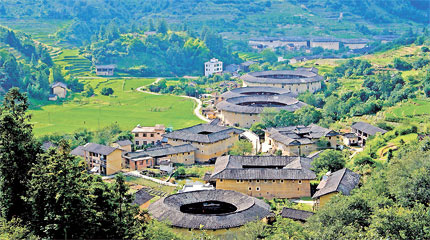Min cuisine takes pride in its variety of yummy soups
|
|
|
The photo shows some homes made of earth, or tulou, in Fujian Province. Fujian's tulous are famous around the country. com |
Min cuisine, one of the eight culinary schools in China, is also known as Fujian cuisine and it originates in coastal Fujian Province.
Light but flavorful, soft and tender and often mixing sweet and sour, Min cuisine dates back 5,000 years. It has earned distinction for sublime seafood and excellent presentation. Cooking methods include simmering, grilling, stewing, baking with red rice wine, braising and salting. Don't forget that pan frying, deep frying and quick frying all play a role in Min cuisine.
The cuisine originated from Minhou County and evolved into three schools, including Fuzhou, Minnan (south of Fujian) and Minxi (west of Fujian).
The Fuzhou school mainly refers to Quanzhou and Xiamen styles, which feature fresh tastes with sweet and sour flavors.
The Minnan school developed in Zhangzhou and is famous for its various sauces and seasonings, featuring sour and slightly spicy flavors.
The Minxi school evolved in Changting. It is generally more salty and spicy and uses delicacies from mountainous areas as its major ingredients.
Red vinasse with red rice wine and the liberal use of sugar and vinegar are two favored methods of Min cooking.
As early as the Tang Dynasty (AD 618-907), red vinasse was introduced to Fujian by merchants from central China. Since then red has been the main color of Min cuisine. Red fish, red pork and red chicken are commonly seen on dining tables across Fujian.
The province is also known for its "drunken" (wine marinated) dishes and is famous for quality soup stocks and bases used for flavoring.
As the province is blessed with abundant natural resources -- a long coastline to the east and vast mountainous regions in the north -- Min cuisine features a lot of mushrooms, bamboo shoots, sugar cane, lotus seeds, river eel, soft-shelled turtle and clams.
Min cuisine boasts a slicing technique dubbed as "thin as a piece of paper and as light as a strand of hair."
According to Min chefs, the natural taste of food can be brought out by fine, proper knife skills and they are strongly opposed to over-fancy and showy cutting techniques. Min cuisine chefs have to follow a set of strict slicing regulations.
Another saying about the region's cuisine goes: "It is unacceptable to have a meal without soup."
As such, Fujian chefs are soup experts. They are very good at using various sauces and seasonings to create all kinds of soups.
Salty seasonings include shrimp sauce, shrimp oil and soy sauce. Sour seasonings are made from white vinegar and qiaotou (a vegetable similar to green onion and garlic). Sweet seasonings include brown sugar and crystal sugar, while brown sugar, spiced powder, aniseed and cassia bark are used to create sweet-smelling seasonings. Spicy seasonings are usually made from pepper and mustard.
Fujian people love soup because they believe it is the most nutritious way to eat and that it brings out the true taste of the ingredients. A bowl of soup with every meal is indispensable for Min people.
Take the famed quick-boiled clams with sanrong soup as an example. The soup is made from ham, beef and chicken after being simmered for hours. The soup is known for its tender fresh clams that leave a long aftertaste.
 0
0 








